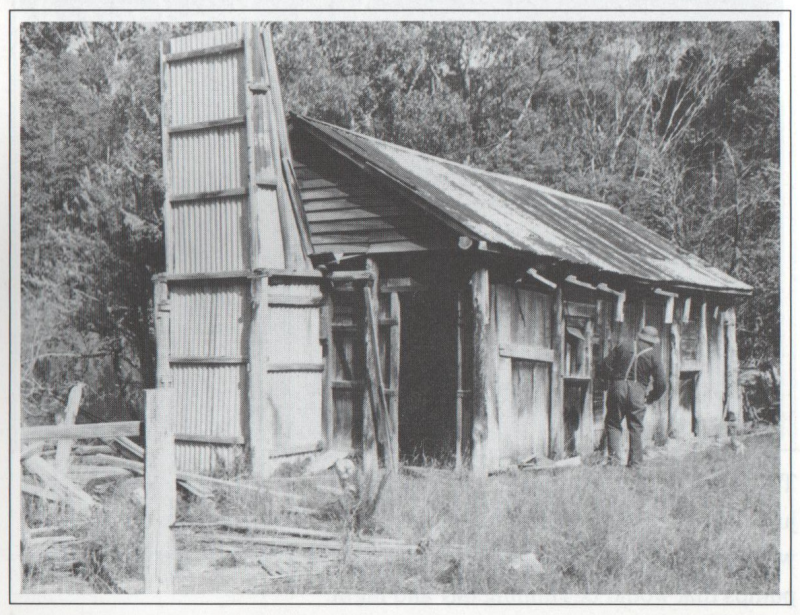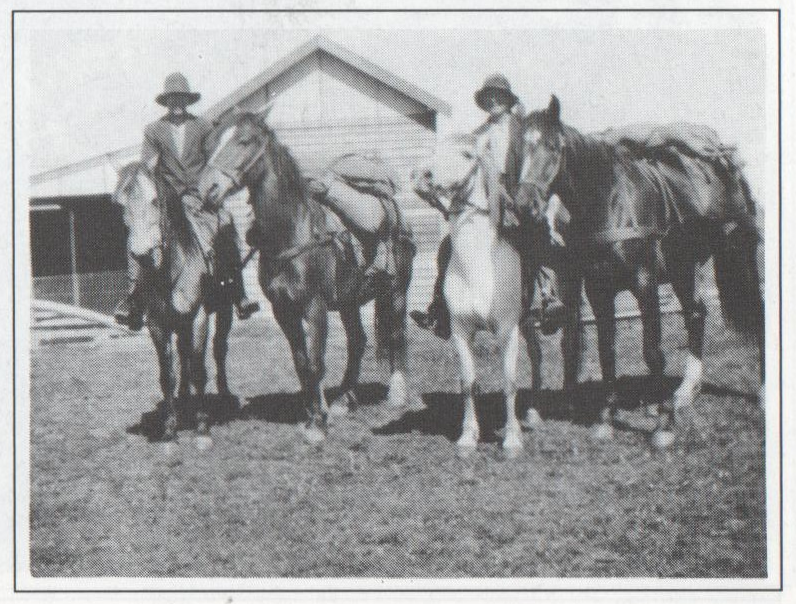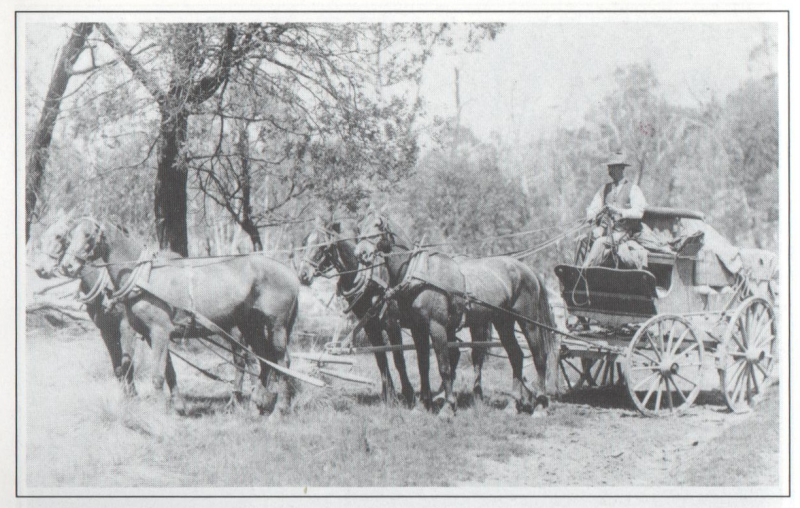Chapter 11 - the Egg Lady Who Taught The Piano And A Place Called Dartmoor
Back then, it snowed in the first week in June every year. It never failed. Set your watch by it, sort of thing.
A couple of weeks before then, we'd troop in to Bendoc and help them get the wood in at the pub for Grandfather. Old Alf Wilson used to come down with two horses and a dray. You'd be chopping, and I'd be chopping, and all hands would be chopping, morning till dusk, to get the pub's winter wood in. They'd give you tea, bed and breakfast for a night or two, and then you'd go home. Money? Money was not there. Ask Bill Mustard for money and he'd run you off the place. Everywhere you'd go in late May, there'd be drays full of wood. Come June, it snowed. That was.a well known thing.
When we got wood for the pub, probably only Alf Wilson got paid. Alf was one of the quietest men around, and we've got more than our share of blokes who don't say much up here. He was a bush battler like us, too, and there's still a link with him in the area, a split timber hut that he built still stands in the bush about three mile from Bendoc, and not a lean on it after eighty years. Fascinating it is - you go into a little clearing and there's these falling fences, bits and pieces of them laying on the ground at various spots. God knows how many hours of tough work Alf put into it. That place is a bridge from times just before today to the start of the century, and they should preserve it somehow. It's a gem of a place but not too many people know it exists still in there, quietly mouldering away.
Eileen was his wife - she was the egg lady for the mine and, as I said a bit earlier, the local piano teacher who didn't own a piano. I spent many an hour having a cuppa as I passed through looking for gold, hunting a rogue dingo or carrying my rabbit traps. A wonderful couple, who never had a lot of anything, would never run nobody down, always helped if you needed a hand; elderly even when I knew them, but always invited you in to perch yourself on a chair, which Alf had made, in front of a giant fire. She'd give me a cake or something she'd cooked. I'm sure I was a favourite of hers. They didn't have any kids, so I think they picked on me.
You know, bits of the fence he put up around his property in 1934 is still there. By Jeez, it was a good one. The place is about three-quarters of a mile further on from the Victoria Mine, and to make ends meet she'd go down there selling eggs. I'd buy them, too, with the money I'd made from rabbits. Or I'd just walk down there for something to do, but you never marched straight in - they had the wildest two dogs in the district. Make mincemeat of you. She used to sell us a seven-pound treacle tin of eggs - one with a handle on it - for one shilling. Whether there was ten eggs in it or a dozen or fourteen, you still paid a shilling. A number of times I'd ride the four mile or so over from Dillon's, fill up my tin with eggs, then canter home. She wouldn't always charge me, because she knew I was keeping the dingoes away and she had a few poddy calves round the house. The dogs came in once and ran her calves down to the river where they drowned. I got the dog for her, so she gave me eggs - that was her contribution.
She always had a lot of chooks. You had to go in along a track off the Clarkesville Road, and that's still there, though not as well defined. There's still a bit of a shed standing where the chickens used to be and that's where they kept those two blue heeler dogs. I would just wait at a gate there or stay on me horse, whatever. 'Never get off your horse until we come out,' she used to say. She didn't need to tell me that really, 'cause I was never going to put my foot on the ground while them dogs was there. The absolute worst in the district they were, two blue merlin cattle dogs. As you approached half a mile away, you'd hear them start snarling.
Alf had two horses and a dray all the time I knew him. and did work for the mine whenever he could. That little hut there now, split logs and tin roof, is built to last forever, and probably will. The loneliness of the place, with its fruit trees half covered in lichen and hardly bearing because of their age, gets to you when you compare it with the warmth it harboured once. Inside the hut today, the one big space has a division cutting it into two, and there's bits and pieces of a table - he'd have made that himself, too - just one small window, and the fireplace at the end.
I remember old Tiger, Mrs Wilson's big brindlecat, laying in front of that fire. He was always there inside in winter and can't say as I blame him much. For some reason, that cat hated snakes, and kept killing them and bringing them back into the house, and there was some four- and five-footers among 'em. It fair drove Mrs Wilson mad to see him carrying one in, 'cause sometimes they weren't real dead - they'd move and give her a fright.
When you go there today, across the width of the house, joining wall to wall, are round beams four inches through. A few old brown bottles lie in dust on the floor, the names of their makers unknown these times. There is dust, loose dirt, pieces of broken furniture everywhere in what was once a neat little room, kept spick-and-span by a gentle, graceful couple. I step inside the door occasionally and have inside my mind the picture of how it was. Now it's only a dream in tatters, of two people long dead. They shouldn't let that go to ruin 'cause, like that other hut, Dartmoor, it's still able to be saved. The closest tree to the hut is patchy, stunted and just recognisable as an apple tree, but it's dying, half-killed by the lichen. A few yards further and there's a pear tree with yellowing leaves, faring a little better, but still only got a limited number of years left. I haven't seen fruit on any of them for a few years, but I suppose, at its age, it's past caring or bearing. There are other trees that look out of place in the bush surrounding. Parts of Alf s wooden fences lay flat on the ground, everywhere traces of a proper pioneer that never made it. Strange, but they had this big bush block of land and didn't run sheep or anything. Never saw a sheep there, nor more than one milk cow on it. and just the two draught horses, chickens, the dogs and the odd poddy cab. There was a bit of a clearing and a vegetable garden round the house, but that was it.
I think the Wilsons did it pretty hard, even I noticed that, and I was real young. I don't think he had the money to clear it properly and it might have been tough for him to do it on his own as he was elderly, fading, even then. I'm only guessing about that though.
God, I had a few cups of tea in that hut. I heard that Alf had hewn the logs and put it up around 1915 or 1916. There's still bits of implements laying about, maybe something the old man used on the roads, and an old rusting plough, on the way to a flaking oblivion. It's just behind the hut next to a series of grassed over furrows, but you can see their outlines quite clearly. Those furrows have lasted as well as the nearby plough that almost surely made them, and have survived the snow and storms of fifty-two years or more. That's tangible. I can still see his thin little frame there, hanging on to the plough behind the one big, grey horse. I can't help it, but I always picture it as a place of unfulfilled hopes.
No one knew the old man had taken sick. It was a rainy sort of day when I bumped into Mrs Wilson on the track outside the property - she was probably coming from one of her piano lessons. Around 1938 it was, when I was about nine years old, and there she was telling me that the old man was bad sick and had been taken to Sydney. I'd not known. She never said what was to happen, and I never saw her again. Word was she just packed a few things and went, and that Alf died not much later. She just walked away from a lifetime; just left it. The property must have gone back to the Crown, I suppose. The Crown has got the land all right, but they don't know about the memories or the Wilsons. They've just left that place to rot. Surely it's worth more? Falling into slow ruin; greying, fading timber and the hours of a man's life that went into it all. I'd love to see it restored and kept up to scratch. People would come to see it. They should put it on the tourist routes.
Old man Wilson was never one to say much at the best of times and he'd hardly pass more than a few words, though he was very pleasant. But that just wasn't with me - he didn't talk much any time. He was the bloke that put the filling in at the Delegate River bridge on The Gap Road. There was a pretty big gang of blokes working there, but Wilson's horse and dray did the heavy work. He had a tip dray and I'd often see him going along the back roads, moving slowly with them two draughthorses - I'd catch his plodding outline through the trees while I was laying rabbit traps or moving through the bush. He'd lift an arm if he saw me.
I said she was a piano teacher, but it's real odd they didn't have one themselves. There wasn't anything musical in that hut that I ever saw. You could often see her walking on the road into Bendoc, going in to teach people there, three and a half miles from her place, and we're not talking about a young woman. She'd walk in, teach the kids or whoever, perhaps walk on to the next lesson, then walk all the way back home. You know all she said that last time I saw her? That old Alf was sick, real sick, in Sydney and would have to hang up his axe. She used that phrase: 'Hell have to hangup his axe.' She never really said goodbye to me. Perhaps it was too sad to mention, because I know they both loved it there, or perhaps she hadn't made up her mind to leave then. So that's the circumstances of how she walked away from it, just two days later. I can't help but often think of it and that lovely little clearing and hut in the bush.
Some things stayed constant, as night and day, in a person's lire. What stayed constant in mine was rabbits, every winter from about the time I was six. It didn't matter that there was four foot of snow on the ground or that ice was covering the ground inches thick for the whole of the day after a severe frost. It just didn't melt some days. Rabbits was our ticket to being able to get by. That was the mainstay of the place up here. Plenty of other families, like the Beasleys and the Jamiesons, were in the same situation as us Mustards. Rabbiting was the main thing for all of us. Some of them used to call it winter sport, but I never ever saw it that way. It was no sport, it was survival. You caught rabbits or you starved. Everyone had to make a quid to feed their family. You could always sell a rabbit skin, oryou could catch one to eat. Four or five good buck skins in mid-winter would weigh a pound. You could feed rabbits to pigs for bacon or to the chooks for eggs. Rabbits kept people from starving, there's no doubt about that.
And that brings me to a hut with a name that spells 'depression', a hut they called 'Dartmoor', and it's still standing, too. Made of cabbage gum logs, split from the surrounding bush and built in 1932 by the Reed brothers, it was my home for months and months over a dozen or more winters. I was talking to George Reed, one of the brothers (there was Jack, George, Charlie and Harry) and he was laughing when he remembered the first time he saw me. 'Just a raggedy little tacker with sacks sewn round ya legs.' He reckoned I'd be about six and was staggering under the weight of a good nine or ten rabbit traps. 'Poor as damn crows', he reckoned me and my brother Roy were. The Reed brothers were only teenagers then themselves, but they'd put that hut up there in the middle of a cattle run they had. It was 125 acres of freehold, though they had other leases in various spots high and low for summer and winter, including one of 10,000 acres, and they used to let the cattle roam the bush anyhow. In our position, we always walked the half dozen miles over there from Dillon's when we were rabbiting. I always maintained it was too cold to ride, anyway. You walked it. Some landholders around Bendoc sold the rights to trap their property, but all the Reeds wanted us to do was keep the rabbits down on their property. The agreement was that we had to keep the rabbits down whether they were worth anything or not, and that was the condition he gave it to us.
What used to happen was that their old man, George, a bit of a big wig in the area, the stock and station agent, used to take the brothers out there the six miles from Bendoc to the Dartmoor property on a Monday, leave them enough tucker, and pick them up on the Friday. He'd have them clearing the place, cutting a bit of timber and ring-barking. The boys didn't like the job much - ringbarking and scrubbing isn't the best way to pass the time for a teenager - so they reckoned they were in jail and named the hut that they built Dartmoor. George Reed called it that, so there must have been some jail called that  somewhere. There was another one they built on one of their runs and they called that 'Sing Sing'. The name Dartmoor was burnt into the door. The hut's still there, but someone has pinched that door and the hut is falling apart; people have put their initials inside. Mine should be burnt on a log near the fireplace still, as I can remember burning 'DM', for Dillon Mustard, into the wood with a white-hot piece of wire. The cabbage gum they used to make that simple little affair is standing up pretty well, though the hut is just a single-room job.
somewhere. There was another one they built on one of their runs and they called that 'Sing Sing'. The name Dartmoor was burnt into the door. The hut's still there, but someone has pinched that door and the hut is falling apart; people have put their initials inside. Mine should be burnt on a log near the fireplace still, as I can remember burning 'DM', for Dillon Mustard, into the wood with a white-hot piece of wire. The cabbage gum they used to make that simple little affair is standing up pretty well, though the hut is just a single-room job.
There's a lot of cabbage gum around here, not a big tree, but one with a big leaf and instantly recognisable because of the wriggly lines on it. Good timber in the ground that cabbage gum, tops for fence posts. A fair bit of it was growing over at the place next door, called Hutchinson's, the place where the wife heard that little kid crying that night, the kid that died up there at the Forks. Don't you worry, I'll get round to that story.
Extract from Martin Thomas, Mountains of Memories, 1991.
Published by Hutchison. ISBN 0 09 182631 4.



